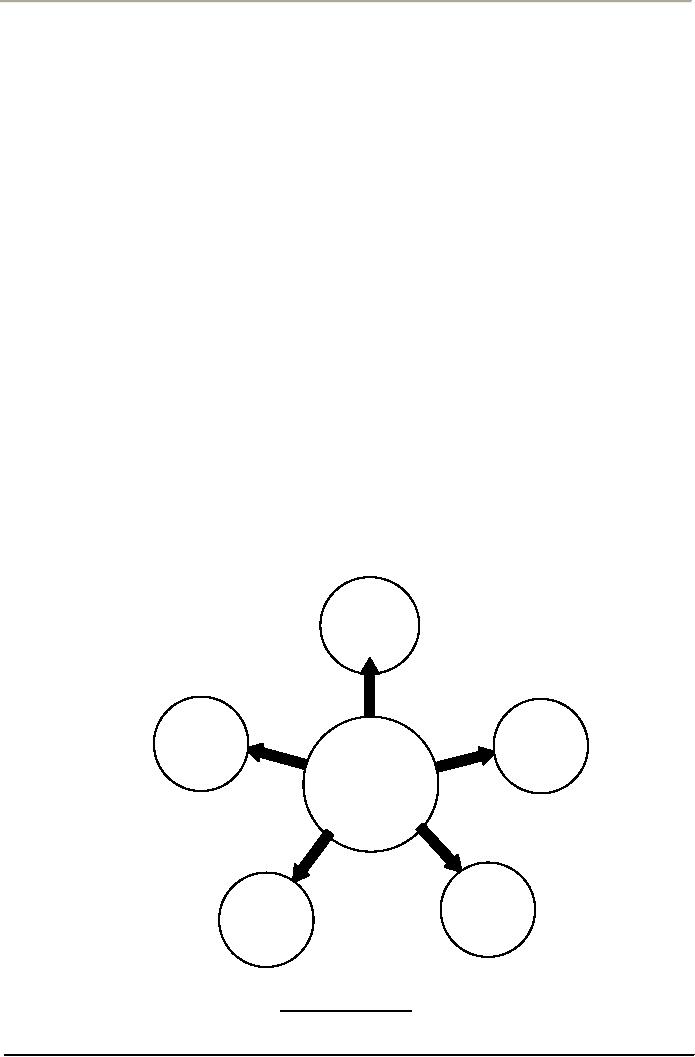 |

Total
Quality Management
MGT510
VU
Lesson
# 15
DEMING
CYCLE AND QUALITY
TRILOGY
Deming
Cycle
Deming
cycle is a tool for
continuous improvement and it is a tool
for an ongoing effort to
improve
products,
services or processes. These
efforts can seek
"incremental" improvement over
time or
"breakthrough"
improvement all at
once.
Among
the most widely used tools
for continuous improvement is a
four-step quality model--the
plan-
do-check-act
(PDCA) cycle, also known as
Deming Cycle or Shewhart
Cycle:
·
Plan:
Identify
an opportunity and plan for
change.
·
Do:
Implement
the change on a small
scale.
·
Check:
Use
data and facts to analyze the
results of the change and determine
whether it made a
difference.
·
Act:
If
the change was successful,
implement it on a wider scale and
continuously assess
your
results.
If the change did not work,
begin the cycle
again.
Deming
cycle was developed to link
the production of a product with
consumer needs and focus the
resources
of all departments (research, design,
production, and marketing) in a
cooperative effort to
meet
those needs. The Deming
Cycle proceeds as
follows:
1.
Conduct
consumer research and use it in
planning the product
(PLAN).
2.
Produce
the product (DO).
3.
Check
the product to make sure it
was produced in accordance with the
plan (CHECK).
4.
Market
the product (ACT).
5.
Analyze
how the product is received in the
marketplace in terms of quality, cost,
and other
criteria
(ANALYZE).
1
Plan
5
2
Analyze
Do
The
Deming
Cycle
3
4
Check
Act
DEMING
CYCLE
53

Total
Quality Management
MGT510
VU
Other
widely used methods of
continuous improvement -- such as
Six Sigma, Lean Production,
and
Kaizen
-- emphasize employee involvement and
teamwork; measuring and systematizing
processes;
and
reducing variation, defects and
cycle times.
Continuous
or
Continual?
The
terms continuous
improvement and
continual
improvement are
frequently used interchangeably.
But
some
quality practitioners make the following
distinction:
·
Continual
improvement: a broader term
preferred by W. Edwards Deming to refer
to general
processes
of improvement and encompassing
"discontinuous" improvements--that is,
many
different
approaches, covering different
areas.
·
Continuous
improvement: a
subset of continual improvement,
with a more specific focus on
linear,
incremental improvement within an
existing process. Some
practitioners also
associate
continuous
improvement more closely
with techniques of statistical process
control.
Juran's
Contribution
Joseph
M. Juran ranks near Deming in the
contributions he has made to
quality and the recognition he
has
received as a result. His Juran
Institute. Inc., in Connecticut,
USA is an international leader in
conducting
training, research, and consulting
activities in the area of quality
management. Quality
materials
produced by Juran have been translated into 14
different languages.
Juran
holds degrees in both
engineering and law. The emperor of
Japan awarded him the Order of
the
Sacred
Treasure medal, in recognition of his
efforts to develop quality in
Japan and to promote
friendship
between Japan and the United States.
Juran is best known for the
following contributions to
the
quality philosophy:
♦
Juran's
Three Basic Steps to
Progress
♦
Juran's
Ten Steps to Quality
Improvement
♦
The Juran
Trilogy
Juran's
Three Basic Steps to
Progress
Juran's
Three Basic Steps to Progress
are broad steps that, in
Juran's opinion, companies
must take if
they
are to achieve world-class quality. He
also believes there is a point of
diminishing return
that
applies
to quality and competitiveness. An example
illustrates his
observation:
Say
that an automobile maker's
research on its cars reveals
that buyers drive them an
average
of 50,000 kms before trading
them in. Applying Juran's
theory, this automaker
should
invest the resources necessary to make
this line of cars run
trouble free for
perhaps
60,000 kms. According to Juran,
resources devoted to improving
quality
beyond
this point will run the
cost up higher than the
typical buyer is willing to
pay.
54

Total
Quality Management
MGT510
VU
I.
Achieve structured improvements on a
continual basis combined
with dedication and a sense
of
urgency.
II.
Establish an extensive training
program.
III.
Establish commitment and leadership on the part of
higher management
Juran's
Ten Steps to Quality
Improvement
Examining
Juran's Ten Steps to Quality
Improvement, you will see
some overlap between them
and
Deming's
Fourteen Points. They also mesh
well with the philosophy of
other quality experts.
1.
Build
awareness of both the need
for improvement and opportunities
for improvement.
2.
Set
goals for improvement.
3.
Organize
to meet the goals that have been
set.
4.
Provide
training.
5.
Implement
projects aimed at solving problems.
6.
Report
progress.
7.
Give
recognition.
8.
Communicate
results.
9.
Keep
score.
10.
Maintain
momentum by building improvement into the
company's regular
systems.
The
Juran Trilogy
The
Juran Trilogy summarizes the three
primary managerial
functions.
Quality
Planning, Quality Control, and
Quality Improvement
55
Table of Contents:
- OVERVIEW OF QUALITY MANAGEMENT:PROFESSIONAL MANAGERIAL ERA (1950)
- TOTAL QUALITY MANAGEMENT AND TOTAL ORGANIZATION EXCELLENCE:Measurement
- INTEGRATING PEOPLE AND PERFORMANCE THROUGH QUALITY MANAGEMENT
- FUNDAMENTALS OF TOTAL QUALITY AND RATERS VIEW:The Concept of Quality
- TOTAL QUALITY MANAGEMENT AND GLOBAL COMPETITIVE ADVANTAGE:Customer Focus
- TOTAL QUALITY MANAGEMENT AND PLANNING FOR QUALITY AT OFFICE
- LEADERS IN QUALITY REVOLUTION AND DEFINING FOR QUALITY:User-Based
- TAGUCHI LOSS FUNCTION AND QUALITY MANAGEMENT
- WTO, SHIFTING FOCUS OF CORPORATE CULTURE AND ORGANIZATIONAL MODEL OF MANAGEMENT
- HISTORY OF QUALITY MANAGEMENT PARADIGMS
- DEFINING QUALITY, QUALITY MANAGEMENT AND LINKS WITH PROFITABILITY
- LEARNING ABOUT QUALITY AND APPROACHES FROM QUALITY PHILOSOPHIES
- TOTAL QUALITY MANAGEMENT THEORIES EDWARD DEMINGâS SYSTEM OF PROFOUND KNOWLEDGE
- DEMINGâS PHILOSOPHY AND 14 POINTS FOR MANAGEMENT:The cost of quality
- DEMING CYCLE AND QUALITY TRILOGY:Juranâs Three Basic Steps to Progress
- JURAN AND CROSBY ON QUALITY AND QUALITY IS FREE:Quality Planning
- CROSBYâS CONCEPT OF COST OF QUALITY:Cost of Quality Attitude
- COSTS OF QUALITY AND RETURN ON QUALITY:Total Quality Costs
- OVERVIEW OF TOTAL QUALITY APPROACHES:The Future of Quality Management
- BUSINESS EXCELLENCE MODELS:Excellence in all functions
- DESIGNING ORGANIZATIONS FOR QUALITY:Customer focus, Leadership
- DEVELOPING ISO QMS FOR CERTIFICATION:Process approach
- ISO 9001(2000) QMS MANAGEMENT RESPONSIBILITY:Issues to be Considered
- ISO 9001(2000) QMS (CLAUSE # 6) RESOURCES MANAGEMENT:Training and Awareness
- ISO 9001(2000) (CLAUSE # 7) PRODUCT REALIZATION AND CUSTOMER RELATED PROCESSES
- ISO 9001(2000) QMS (CLAUSE # 7) CONTROL OF PRODUCTION AND SERVICES
- ISO 9001(2000) QMS (CLAUSE # 8) MEASUREMENT, ANALYSIS, AND IMPROVEMENT
- QUALITY IN SOFTWARE SECTOR AND MATURITY LEVELS:Structure of CMM
- INSTALLING AN ISO -9001 QM SYSTEM:Implementation, Audit and Registration
- CREATING BUSINESS EXCELLENCE:Elements of a Total Quality Culture
- CREATING QUALITY AT STRATEGIC, TACTICAL AND OPERATIONAL LEVEL
- BIG Q AND SMALL q LEADERSHIP FOR QUALITY:The roles of a Quality Leader
- STRATEGIC PLANNING FOR QUALITY AND ADVANCED QUALITY MANAGEMENT TOOLS
- HOSHIN KANRI AND STRATEGIC POLICY DEPLOYMENT:Senior Management
- QUALITY FUNCTION DEPLOYMENT (QFD) AND OTHER TOOLS FOR IMPLEMENTATION
- BASIC SQC IMPROVEMENT TOOLS:TOTAL QUALITY TOOLS DEFINED
- HOW QUALITY IS IMPLEMENTED? A DIALOGUE WITH A QUALITY MANAGER!
- CAUSE AND EFFECT DIAGRAM AND OTHER TOOLS OF QUALITY:Control Charts
- STATISTICAL PROCESS CONTROL (SPC) FOR CONTINUAL QUALITY IMPROVEMENT
- STATISTICAL PROCESS CONTROLâ¦.CONTD:Control Charts
- BUILDING QUALITY THROUGH SPC:Types of Data, Defining Process Capability
- AN INTERVIEW SESSION WITH OFFICERS OF A CMMI LEVEL 5 QUALITY IT PAKISTANI COMPANY
- TEAMWORK CULTURE FOR TQM:Steering Committees, Natural Work Teams
- UNDERSTANDING EMPOWERMENT FOR TQ AND CUSTOMER-SUPPLIER RELATIONSHIP
- CSR, INNOVATION, KNOWLEDGE MANAGEMENT AND INTRODUCING LEARNING ORGANIZATION